M-209: Handling messages
Introduction
In this page we describe how a message was created, ciphered (by M-209) and transmitted during World War II in the US Army.The information given here comes from a document published by War Department: "BASIC FIELD MANUAL, Signal Communication, (FM 24 -5)" in 1942. It describes in great details the organization about managing message. There is also a movie which explains this organization.
The most important organization managing messages is "Message Center". The message center is the agency of the commander at each headquaters or command post charged with the receipt, transmission and delivery of all messages. A message center of a division contains an important staff: Message Center Chief , Dispatcher, Code clerks, many Operators (Radio, Telegraph, ...) and many messengers. In a smaller center, one man can play many roles.
In the following paragraphs, we describe the different steps of managing a message. The pin and lug setting used come from the TM 11-380, 1944.
Handling outgoing messages
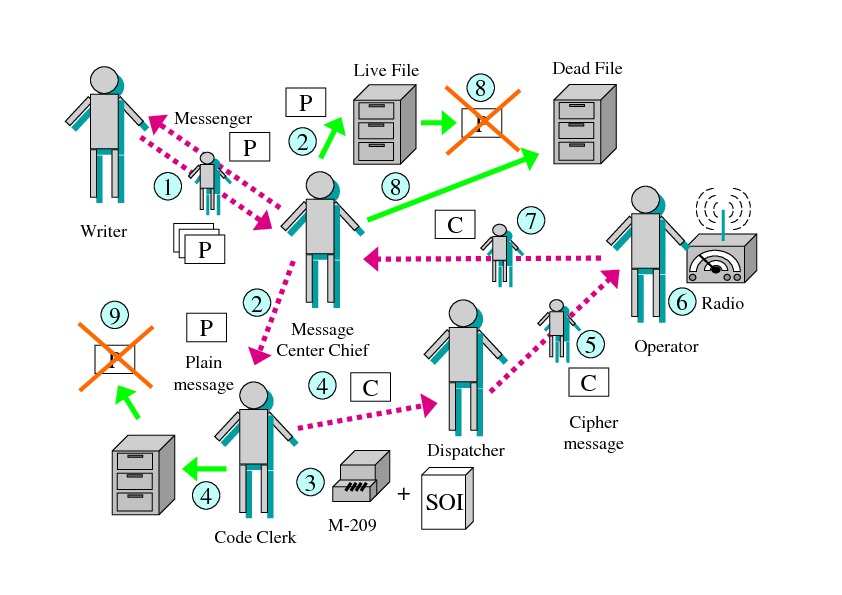
1. Creation of a message
An officer having authority to emit a message (a commandant of a military unit) writes a message. He uses a special form to do it: a message book M-210. Each form is 4-3/4 in Width x 4-1/2 in Heigh (12x11.4 cm). You can download an empty M-210 form on NF6X's site The message is writen in three copies (original and two carbon copies). The officer transmits his message to the message center. Usually, a messenger carries the message.Here the different parts of the message:
- Priority (Urgent [O], Operational Priority [OP], Priority [P],
Routine [ ]
, Deferred [D]) - Message Number
- Date
- Addressee (To)
- The message
- Sender (From)
- Time
- Signature
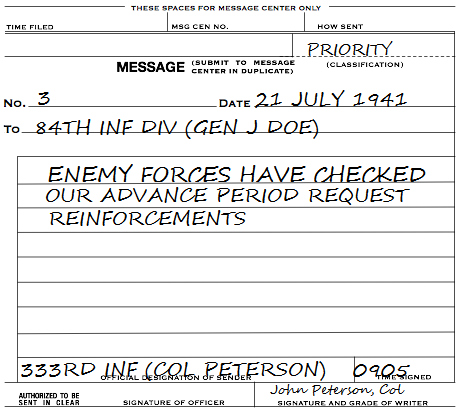
2. Handling the message by Message Center Chief
The message center chief receives the message in duplicate from the writer or a messenger, making sure that the person submitting the message is known to him.He inspects the message for legibility and proper address.
He stamps the time of receipt on the back of both copies. He also copies the time on the "time filer" case at top of the form.
He writes the message center number (beginning a new series of numbers at midnight each day). He checks the message center number off his number sheet by drawing a diagonal line through the number corresponding to the message center number assigned to the message (an empty sheet).
He determines the means (Radio, Pigeon, messenger, ...) by which the message shall be transmitted. The Reference Chart shows him the different possibilities:
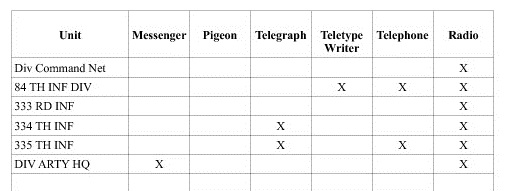
Then, he writes the abbreviated name of the means at the top of the message (RAD for Radio, TG for Telegraph, TP for Telephone, Pgn for Pigeon, Tt for Teletypewriter, Vis for Visual, Msgr for Messenger, ...).
If the message is to be transmitted as a cryptogram, he passes the original of the message to the code clerk and files the duplicate copy in the live file. He gives the other copy to the messenger who returns it to the writer.
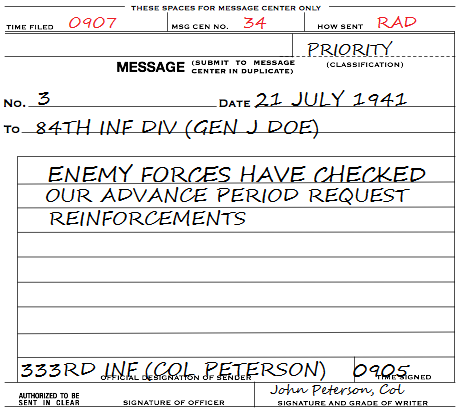
3. The code clerk enciphers the message
The code clerk receives the original of the message from the message center chief.Before enciphering the message, he transforms it (Drafting): he uses authorized abbreviations (PD for PERIOD for example) and condensation and adds sometimes the addresses inside the message. He spaces words by letter "Z".
When addressee and sender addresses correspond directly to the Call Signs, these are sufficient to handling the message. When addresses specify commanding officers, the addressee address is inserted at random within the body and near the beginning of the message preceded by the word "For" (or "To"), and the identity of the writer of the message near the end of the message preceded by the word "From". The position of these insertions varies in order to maintain cryptographic security.
The addresses are enclosed by parenthesis. As the punctiation marks are spelled, a parenthesis is remplaced by the word "PAREN". Now, we can understand the affirmation of the German cryptanalysts that the word "PAREN" can always be found in a depth.
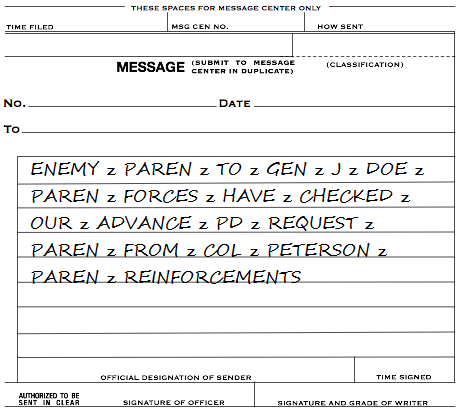
He enciphers the transformed message (for the example, I used the internal setting of the TM 11-380 1944).
He fills a new M-210 form:
- The message center number
- The transmission means (example: RAD)
- The Call Signs (example: G2E7 V U1N6)
- The priority (example: P [for Priority])
- The original Message Number (from writer)
- The enciphered message (surrounded by indicators). In fact, he pastes the tape produced by M-209 cipher machine on the form.
- The original time (from writer)
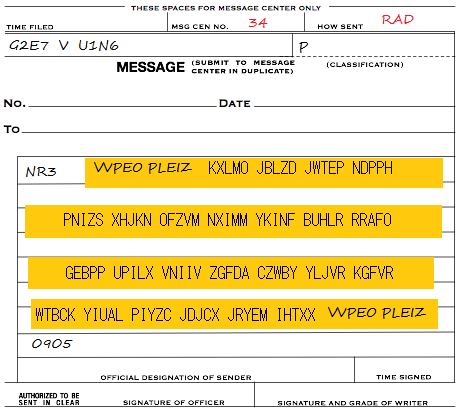
Remark: The code clerk uses the Signal Operation Instructions (SOI) to find the M-209 Internal settings and Call Signs of correspondents. By means of it, the Radio Operator knows the frequency to use to send the message.
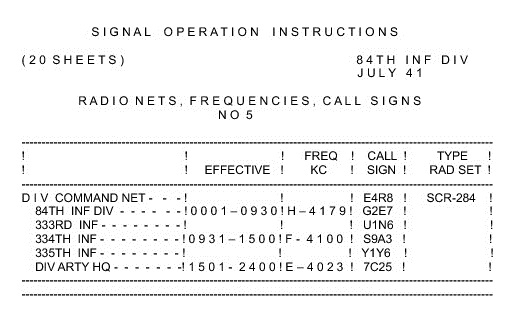
4 & 5 Code clerk transmits the enciphered message to the operator
Then, the code clerk passes the cryptographed message to the operator, or to the messenger dispatcher when the message is to go via messenger.He files the original of the clear text message in his file.
Finally, he destroys all work sheets by burning.
Remark: The plain message and ciphered message are never stored together.
6 & 7. The operator transmits the message
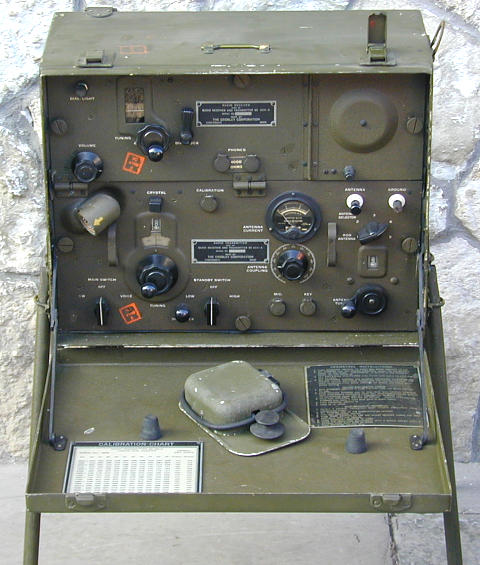 The operator (most usually, the radio operator), receives the
cryptographed text message from the code clerk.
The operator (most usually, the radio operator), receives the
cryptographed text message from the code clerk.
He inserts a timestamp after the call signs, a station-to-station serial number and the number of groups of the message.
He transmits the message and receives a receipt from the distant operator (listen the message in Morse code).
He adds on the message form the transmit time and his initials.
Finally, he returns the message to message center chief.
The Radio Operator manual (TM 11-454) describes in details all Radio procedures.
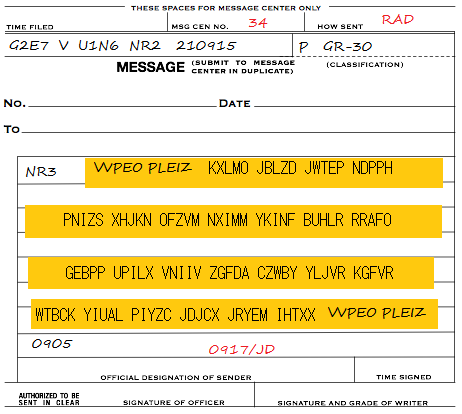
8. The message center chief archives the message
The message center chief receives the enciphered message from the operator.He archives it in the Dead File and destroys the plain message which was stored in the live file.
9. Managing original clear message
The code clerk disposes the plain message in his file as directed by the unit signal. For example, he destroys it after a while when he is sure the enciphered message was deciphered correctly by the remote code clerk.Handling incomming Messages
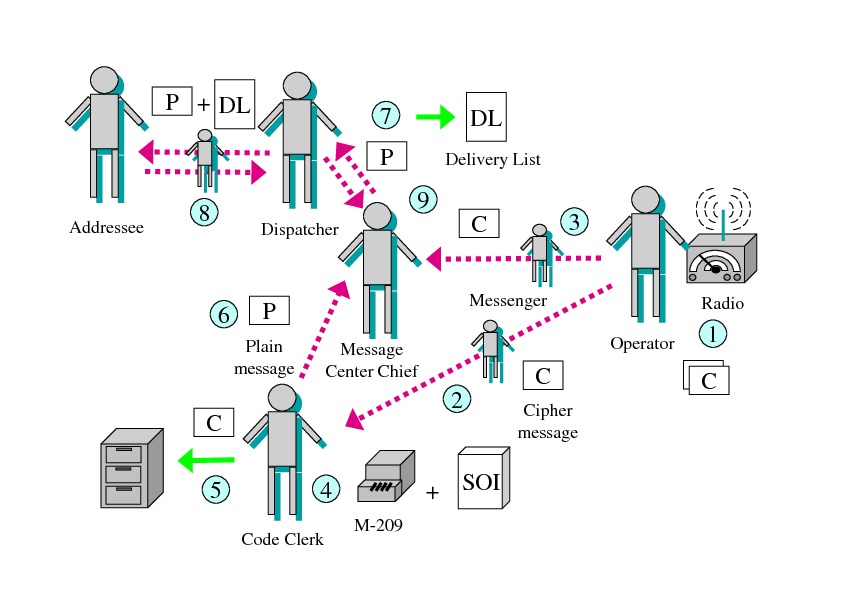
Messages received at a message center for delivery to local addressees may be handled in the manner indicated below. Incoming messages are not assigned message center numbers.
1 & 2 & 3. The Radio Operator receives and transmits the message
a. Operator [for example, the Radio Operator](1) Copies the message in duplicate.
(2) Services the message, entering sign under the message, inclosed in a circle.
(3) If the message is in clear ....
(4) If the message is cryptographed passes or delivers Original of the message to the code clerk, and Duplicate to the message center chief when no longer needed for verification.
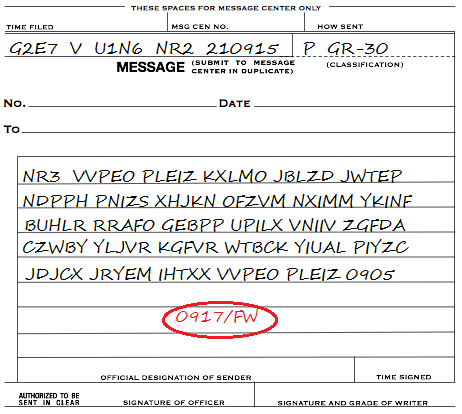
4 & 5 & 6. The code clerk deciphers the message and transmits it
c. Code Clerk.(1) Receives the original of the cryptogaphed message from the operator.
(2) Verifies the authenticity of the message and writes or stamps the words "Authenticated" or "Not authenticated" on the face of the clear copy of the message.
(3) Decryptographs the message, making an original only.
(4) Enters the official designations of the addresses and the sender, as determined from the call signs or from the designations inclosed in parentheses and the call signs, the date, time signed, and the operator's heading (if any) or the distant message center date (if any) in their proper places on the decryptographed copy of the message.
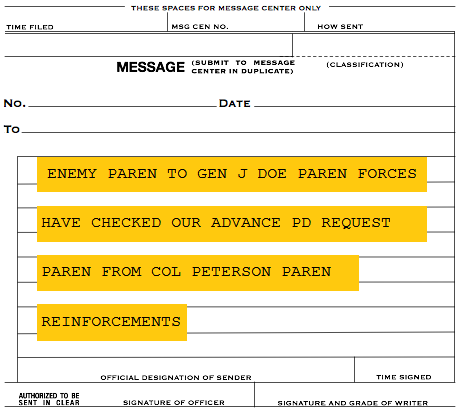
(5) Passes the message to the message center chief, files the original cryptographed copy of the message in his file for reference, and disposes of this file as directed by the unit signal or communication officer. (6) Destroys all work sheets by burning.
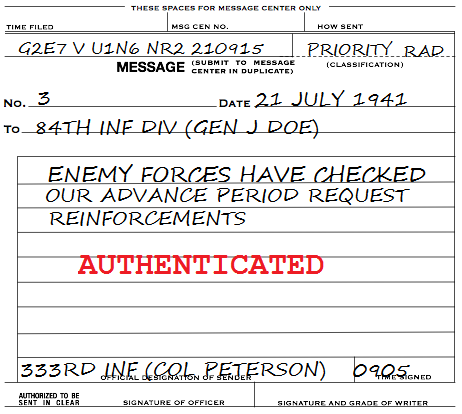
7 & 9. The dispatcher prepares a delivery list
d. Messager dispatatcher.Receives the original of a clear text message from the message center chief and
(1) Prepares a delivery list as follows (a DL filled):
(a) Enters a serial number on the upper right-hand corner of the local delivery list.
(b) If the message arrived via messenger ...
(c) If the message arrived by a means requiring an operator, he enters the headquarters or station of origin, the station-to-station serial number (if the message is in the normal form) or the time signed (if the message is in the abbreviated form), and the means of communication by which the message arrived in the left-hand column of the local delivery list.
(2) Designates a messenger to deliver the message,
(3) Stamps or writes the time dispatched on the delivery list when the
messenger is ready to depart.
(4) Hands the message(s) and the delivery list to the messenger and
gives him the necessary additional instructions for the delivery
of his message(s).
(5) Stamps or writes the time returned in the upper right-hand blank
of the delivery list when the signed delivery list is returned
to him by se messenger.
(6) Hands the completed delivery list to the message center chief.
8. The messenger delivers the message to the addressee
e. Messenger(1) Receives the message and the delivery list from the messenger dispatcher.
(2) Delivers the message and the delivery list to the addressee and obtains his signature, and in the case of the route delivery list, the time received.
(3) Returns to the message center and enters his name, initials, of his messenger number as required by local regulations, on the delivery list for identification.
(4) Hands the delivery list to the messenger dispatcher.
Complements
Procedure in Headquarters below division
In describing the procedure, duties are outlined for message center chief, messenger dispatcher, code clerk, messenger, and operators of the several means of signal communication. This division of duties is functional and is made for convenience in description.In small message centers, one man may perform all the duties. Radio operators are authorized to cryptograph and decryptograph messages when their radio station is separated from their message center by an appreciable distance or there is no message center.
Message center procedure is not dependent on forms. No equipment other than pencil, paper, timepiece, and the authorized codes and cipher devices is required. Certain forms such as delivery lists, number sheets, field message books, and message envelopes are, however, usually provided for convenience and to save labor.
RECORDS
The message center keeps only sur temporary records as are
required to insure rapid and accurate handling of message
traffic. The following records are usually kept:
a. Number sheet - Message center numbers are assigned to each outgoing message. If desirable, the chart which indicates the means which to be used to established communication with the different units, can be merged with the number sheet into a message center log.
b. Receipt form - The receipt form may be a delivery list, message envelope, message blank, or blank sheet of paper. If an acknowledgment has been requested by the writer, notation of this fact will be made on the receipt form.
c. Live file - The live file consists of a duplicate or skeleton copy of each outgoing message which has been sent to a signal agency for transmission but for which a receipt has net yet been obtained.
d. Dead file - The dead file consists of the duplicate or skeleton copies of all receipted outgoing messages...
e. Code clerk's file - This file contains the original clear copy of all outgoing messages sent as cryptograms and the original copies of all incomming cryptographed messages. Caution: Clear and cryptographed copies of the same message must never be filed together. The file is disposed of daily as directed by the unit communication officer.
Station Records
Operator's Number Sheet
Records of messages handled are kept on the operator's number sheet. Entries are made according to the instructions printed at the top of the number sheet. A line drawn through several numbers indicates a group of messages sent in a string.Reception of Messages by Radio Operator
All received messages are copied at the radio station in duplicate. Messages are copied on the typewriter or by hand... When copied by hand, the same number of code groups should be copied on each line. In using the typewriter, 5 or 10 code groups will constitue a line.
References
- BASIC FIELD MANUAL, Signal Communication, 1942 (FM 24-5)
- MARK'S TECH JOURNAL - Message Book M-210
- Message Center Procedure (1942) [Training Film] TF 11-671
- iLord.com - Message Book, M-210, Signal Corps, U.S. Army
- The Radio Operator manual (TM 11-454)
- N6CC - Navy 6 Combat Comms - Radio Set SCR-284
- War Department - Radio Set SCR-284-A TM 11-275
- Extracts From History: Signal Corps Envelope : M-40